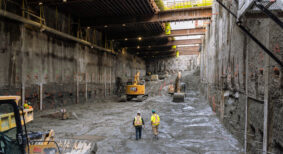In an era defined by rapid changes due to political, financial, environmental, and global health challenges, the construction sector must adapt quickly to maintain its edge. A critical tool in achieving this is the digital twin – a powerful, virtual representation technology easily accessible via the digital devices we’re using on-site daily.
What is a Digital Twin?
Applied to the construction and infrastructure sectors, the digital twin is a comprehensive technology platform that merges data across all stages of the built environment—from design and construction to operations. This integration through a unified and federated platform makes the digital twin an indispensable resource for managing the myriads of risks associated with external events.
Core Components of the Digital Twin
In the realm of construction technology, various innovative tools are paving the way for more efficient project management and execution. Starting with pre-construction technologies, tools like Building Information Modeling, specification technologies, and budgeting systems provide a foundational framework for upcoming projects. As they progress into the planning stage these scheduling technologies become essential and not only help in planning the timelines but also in verifying and optimizing schedules to accommodate unforeseen changes.
Project management tech is at the core of the digital twin, facilitating the comprehensive management of projects by involving all stakeholders. Originally employed for document management, these platforms have evolved to become the central repository for all elements of the digital twin. Another critical aspect, supply chain intelligence, allows project managers to prequalify partners and provides real-time insights into supply chain disruptions and pricing, a feature that has grown in importance in light of recent economic fluctuations.
Another component of the digital twin, reality capture technology, plays a pivotal role by enabling frequent digital snapshots of the construction site. This ensures that the project adheres to its plans and helps in identifying costly errors early on in the process. Such technology is especially beneficial for financial officers concerned with verifying work completion before processing payments to subcontractors and suppliers.
The construction phase Internet of Things (IoT) backbone integrates various devices into a unified platform. These devices monitor real-time conditions on the jobsite and can offer predictive analytics, turning a construction site into a dynamic, responsive environment. Additionally, external event monitoring technologies are employed to keep a vigilant eye on external threats like extreme weather or geopolitical unrest, which could potentially disrupt the jobsite activities.
Finally, the integration of operational phase technologies marks a significant milestone in the lifecycle of a built asset. By merging the operational and construction phases of the project, the digital twin optimizes the total cost of ownership and extends its functionality across the entire lifespan of the asset.
By integrating these components, the digital twin revolutionizes how construction projects are managed. Stakeholders gain enhanced awareness and predictive capabilities, leading to enhanced decision-making. This integration also fosters improved collaboration across projects, supporting more advanced and cooperative procurement models. Ultimately, the digital twin serves to boost productivity, reduce risks, and provide significant societal benefits.
For organizations aiming to efficiently navigate the complexities of modern construction and prepare for future challenges, investing in digital twin technology is essential. It not only equips businesses to address current issues but also prepares them for upcoming demands, ensuring long-term sustainability and success in this consistently competitive environment.
David Bowcott is managing director and co-leader, NFP North American Construction & Infrastructure Group.









